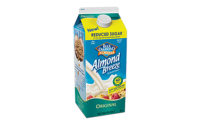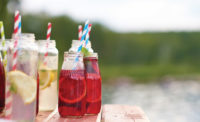Better-for-you products are on the shopping lists of many consumers these days and that includes the nondairy beverages they put in their baskets or grab on the go.
“In general, today’s consumers want healthier refreshment,” said Gary Hemphill, managing director of research at Beverage Marketing Corp., New York. “Each consumer may define healthy slightly differently, but overall products that have healthy attributes are performing better than those that don’t.”
He anticipates continued growth from bottled water — both still and sparkling — and sees ready-to-drink teas, almond milk, energy drinks and sports drinks as also doing well.
Read the entire Industry Outlook
“In general, niche categories are performing better than larger traditional, mass market categories,” Hemphill explained, adding that consumers are also receptive to beverages that provide specific functional benefits.
Though orange juice reigns in the refrigerated juice and drinks category, sales are stagnant. Information Resources Inc., Chicago, said sales were $3.4 billion in the 52 weeks ended Aug. 11, 2013. Sales rose a scant 0.6%. Processors would be wise to consider juice and drink smoothies (sales up 30.7%), vegetable juice/cocktail (22%) and the small but growing cranberry cocktail/drink (102%). (See table above)
Here’s how processors of nondairy beverages are meeting those consumer demands.
Frozen fruit/vegetable juice
Old Orchard Brands’ Fruit & Veggie frozen concentrate hit stores this September — the Sparta, Mich.-based company said it’s a first-ever for the frozen aisle, moving fruit and vegetable juice blends beyond shelf-stable bottles and boxes. Available in blueberry pomegranate, peach mango, and strawberry banana, each 8-ounce serving contains one serving of fruit as well as one serving of vegetables.
“Fruit & Veggie combines carrots, sweet potatoes and beets with fruits like peaches, mangos and strawberries to create a line that fits the better-for-you profile with real nutritional value but is also very drinkable and kid-friendly,” said Kevin Miller, vice president of marketing.
An expansion of its Old Orchard for Kids line will debut in November with three new flavors: berry, fruit punch and grape. All have 50% less sugar than 100% apple juice and 100% daily value of Vitamin C, both benefits highlighted on the 64-ounce shelf-stable bottles.
“There is an established market for this kind of juice for toddlers,” Miller adds, “but these new flavors are geared more towards that transition into childhood when flavor preferences enter the equation.”
The brand uses its online fan club and social media to connect with consumers. Visitors can play games and earn points they redeem for coupons and other prizes, view recipes and see diet and fitness tips. A registered dietician, certified wellness coach and personal trainer interact with users.
“It’s not just about promoting products,” Miller explained, “but practicing what we preach about promoting good, healthy beverages and choices that contribute positively to overall health.”
At this year’s Natural Products Expo West, GoodBelly (manufactured by NextFoods, Boulder, Colo.) launched a new flavor, Carrot Ginger (its first probiotic veggie beverage) as well as new gluten-free family-sized quarts in three flavors: Tropical Orange, Pink Grapefruit and Fermented Probiotic Coconut Water. All are made with gluten-free oat flour.
New packaging was introduced this summer for unified brand design as well as a better on-shelf block effect. Quarts include a black background and specific ingredients illustrated for each flavor alongside a glass of juice. The word “probiotics” is featured in large text on the front to highlight that feature.
CEO Alan Murray said the company has seen increased demand from consumers for probiotics, but that there is still “a lot of confusion about different strains and their benefits.”
GoodBelly uses its website, newsletters and free webinars to help educate consumers.
Honest Tea, Bethesda, Md., reformulated its entire children’s line this year to eliminate organic cane sugar, replacing it with additional juice. The 6.75-ounce pouches remain at 40 calories and sugar per serving dropped from 10 grams to 9 grams. Available flavors include Tropical Tango Punch, Appley Ever After, Berry Berry Good Lemonade, Goodness Grapeness and Super Fruit Punch. The latter three are also available in 59-ounce bottles. Packaging was also updated for a cleaner, simpler look with fruit photos that highlight each flavor.
In April, The Fave Juice Co., Middletown, N.J., rolled out nationally in both Meijer and H-E-B stores. Three flavors — strawberry-banana-kiwi, pomegranate-blueberry-goji and tangerine-orange-pineapple — are available in 46-ounce PET bottles. Based on customer feedback, the company is investigating single-serve sizes as well as a new flavor centered on peach and acai berry.
The all-natural fruit and vegetable juices are gluten-free and contain no added sweeteners. President and Chief Marketing Officer David Kirkpatrick noted that despite multiple new product introductions in the shelf-stable category, it has seen declines for a decade. But with early consumer acceptance of Fave, “we believe it can add significant value to the category.”
The greatest opportunity for growth, he said, is through consumer education regarding calories, added sweeteners and daily vegetable servings. Scale is a challenge for the company and while it added new state-of-the-art bottling equipment in 2012 (including a new filler and shrink-wrap labeler) to its California facility, transportation expense remains an issue so there is the possibility of one day opening a second bottling facility closer to the East Coast.
Silk (owned by WhiteWave Foods) expanded its Fruit & Protein juice blends (mango peach, strawberry banana and mixed berry) with the addition of refrigerated half gallons. Previously they were only available in quarts.
Cold coffee is hot
Iced and frozen coffee is no longer relegated to a warm-weather seasonal drink. Consumers — especially those age 18 to 24 — seem to be reaching for cold coffee year-round. According to Mintel, 20% of all U.S. consumers drink iced coffee while 34% of the younger generation (18 to 24) does.
“Cold coffee, especially frozen-blended, has become very trendy in major U.S. cities such as New York, but it is more than just a momentary fad,” said Mintel’s global drinks analyst Jonny Forsyth in a press release. “Its usage has been building for the last few years and actually reflects the changing tastes of the younger generation.”
StudyLogic, Cedarhurst, N.Y., reports that U.S. sales of the blended coffee drink category grew to $4.3 billion in 2012. Manufacturers are responding to the trend by launching their own ready-to-drink options.
Traditional dairy processors are making gains in the refrigerated, ready-to-drink coffee space. WhiteWave (a stand-alone company spun off from Dean Foods) holds the top spot with its International Delight brand and the No. 5 spot with Silk. Upstate Farms and Prairie Farms hold the No. 9 and 10 positions. (See table.)
In June, Blue Diamond debuted Almond Breeze Iced Coffees, a blend of Arabica coffee and almond milk sold in four flavors: original, mocha, vanilla and caramel macchiato. As with all of the company’s products they are vegan, gluten-free and non-GMO certified. Sold in half-gallon containers, each one-cup serving contains 100 calories.
Seattle’s Best Coffee teamed with Inventure Foods Inc. for its June introduction of Frozen Coffee Blends in Coffee Chiller, Creamy Caramel, Very Vanilla and Mega Mocha. Sold in the freezer section, each package contains two 8-ounce servings. Consumers blend the product with soy, nut or cow’s milk. Each serving has zero trans fats, 10 grams of sugar and 130 calories or less.
Even Old Orchard, best known for its frozen and bottled juices, is getting into the java mix in the coming months. The company will start with two SKUs: a café mocha and a café caramel, both in PET plastic 12-ounce frozen concentrate packaging. Made with coconut milk (in the concentrate), consumers empty the can into a pitcher or a blender to reconstitute into 48 ounces of iced coffee.
“We’ve seen blended and iced coffees taking off in the café/retail environment over the past 36 months as coffee is no longer an a.m. beverage,” said Miller. “It now spans across the day as snacks, pick-me-ups and sweet treats. We believe there is a great opportunity to bring that iced and blended coffee consumer into the frozen aisle for a more affordable café experience they can enjoy at home.”
By shaking up frozen concentrate offerings, Old Orchard also hopes to bring new shoppers to the aisle, “in turn exposing them to all the great beverage options found in that space,” Miller added.
WhiteWave, Blue Diamond invest Demand for its coconut milk products led WhiteWave Foods to introduce its Silk PureCoconut Unsweetened in July. It has no added sugar and is 45 calories per serving. Two new almond milk products also hit refrigerated shelves this year, Silk PureAlmond Lights available in original and vanilla. Each has one-third fewer calories than the brand’s original almond milk.
“Consumer demand for all types of plant-based foods and beverages continues to grow,” said Sara Loveday, spokesperson for WhiteWave Foods. “Household penetration of the plant-based category is up 3% year-over-year as consumers continue to look for healthy great-tasting dairy-alternative products.”
To meet growth, WhiteWave invested more than $90 million in manufacturing plants in 2012 to install five new production lines and plans to invest $150 to $160 million this year to support additional growth.
Twitter and Pinterest allow Silk to curate recipes and articles that may be of interest to consumers as well as provide an outlet for engagement.
“We know many of our consumers would rather post to our Facebook page than call our 1-800 number,” Loveday said, “so this outlet allows us another way to provide them the information and support they need when it comes to our products.”
Blue Diamond’s Suzanne Hagener, group marketing manager, sees bringing new customers into the category as the greatest growth opportunity.
“We’ve found that once consumers try our product, they love it,” she said. In March, the Sacramento, Calif.-based brand launched an 11-ounce single-serve chocolate flavor in aseptic packaging. This summer Blue Diamond Almond Breeze Almondmilk co-sponsored Dole’s Peel the Love Summer Food Truck Tour. The 4,800-mile trip aimed to spread a message of nutrition and healthy eating. Visitors to the food truck could enjoy samples and receive recipe cards, coupons and free giveaways.
This year, Blue Diamond invested heavily in its plants. In March it opened a 6,500-square-foot Almond Innovation Center at its Sacramento headquarters. In June, a new state-of-the-art 200,000-square-foot plant was opened in Turlock, Calif.
Honest Tea discloses all
In the refrigerated tea category, private label holds the top spot, as measured in dollars and units sold. The top branded teas are Red Diamond, Gold Peak (a unit of Coca-Cola) and Turkey Hill (Kroger’s). (See table.)
To respond to consumers seeking more unsweetened and zero-calorie beverages, Honest Tea this October rolled out Unsweet Lemon Tea nationally. The new beverage is Honest Tea’s first unsweetened option in the company’s 16.9-ounce bottled line and follows last year’s launch of “Not Too Sweet” tea, a lower sugar version of a country-style tea.
As with all of the brand’s packaging, this new offering uses on-bottle logos and callouts to highlight the fact that beverages are gluten-free and contain no GMOs or high fructose corn syrup.
“We have both a ‘NO GMOs’ logo on the back of all of our labels near the nutrition facts panel,” said Public Relations Manager Joanna Seiden, “as well as a statement that reads ‘No GMOs means that if there is a bioengineered version of an ingredient, we don’t use it.’”
Honest Tea actively uses social media to strengthen its relationship with consumers. Seiden said Twitter and Facebook are great platforms where they can interact directly with customers, by answering questions, helping with product location or just chatting.
“We also try to share content that is useful,” she added. “Whether it’s an inspirational quote and stories of people being honest, to recipes, refreshment tips or ways to decrease one’s overall environmental footprint.”
Fruit-flavored water
Earlier this year, Sparkling ICE (owned by Preston, Wash.-based TalkingRain Beverage Co.) introduced three new lemonade flavors: Raspberry Lemonade, Strawberry Lemonade and Lemonade with Tea to go along with its Classic Lemonade, launched in 2012. The brand went national in 2010 and is one of the fastest growing nonalcoholic beverage lines in the United States. The naturally flavored sparkling water has zero calories and is available in 17-ounce plastic bottles.
Also this summer, Sparkling ICE debuted its first ad campaign as well as a website redesign to further push its growth. A 30-second national TV spot is complimented by billboards and building-side spectaculars and the brand was an LPGA sponsor this summer.










